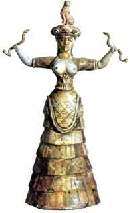


 |
 |
 |
| 1600BC
Minoan Snake Goddess |
Madame
de Pompadour, 1759 |
1760
Stays with spiral lacing and hip tabs |
Corseting
is
not new and has
been
practiced throughout human history. As an example, the Minoan
Snake Goddess, approx. 1600 BC, is usually depicted with a corseted torso. What
draws attention
is the degree of modification.  Today,
light modification from a girdle,
all-in-one, long-line bra or waist cinch is
considered
acceptable and not
unusual. A laced
corset however, draws attention because it's long
standing
symbolism and overt action. The bra, girdle and all-in-one are
meant to enhance, but also to be concealed, allowing the wearer to
pretend
having a better physique.
Today,
light modification from a girdle,
all-in-one, long-line bra or waist cinch is
considered
acceptable and not
unusual. A laced
corset however, draws attention because it's long
standing
symbolism and overt action. The bra, girdle and all-in-one are
meant to enhance, but also to be concealed, allowing the wearer to
pretend
having a better physique.  The
corset's effect by comparison is
more dramatic, and with a clear shaping purpose
if worn as
an outside garment.
It simultaneously
expresses
independence, femininity and elegance, but also power and dominance. Men
of all orientations, are into wearing corsets as well,
primarily because they enjoy
the support and the feeling of constriction. From
this perspective the
corset is gender neutral. A
particular shape will enhance gender
specific features, but by itself constriction and body modification is
not gender or orientation specific.
The
corset's effect by comparison is
more dramatic, and with a clear shaping purpose
if worn as
an outside garment.
It simultaneously
expresses
independence, femininity and elegance, but also power and dominance. Men
of all orientations, are into wearing corsets as well,
primarily because they enjoy
the support and the feeling of constriction. From
this perspective the
corset is gender neutral. A
particular shape will enhance gender
specific features, but by itself constriction and body modification is
not gender or orientation specific.